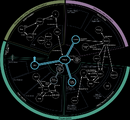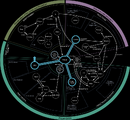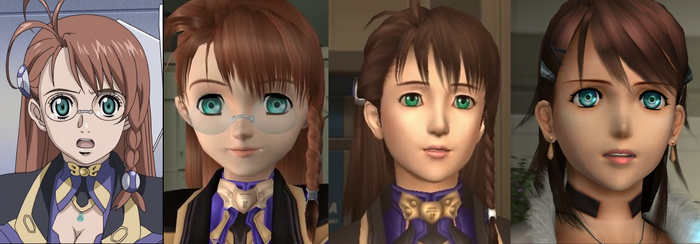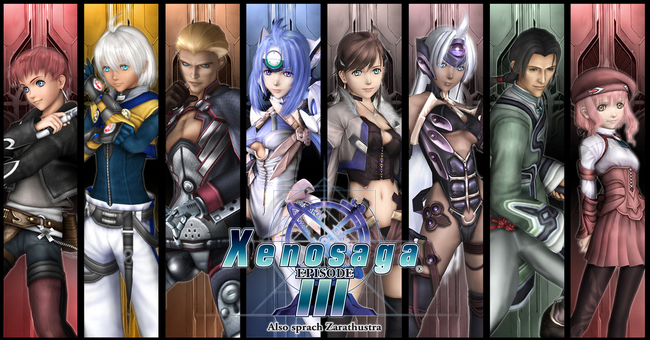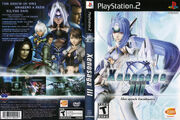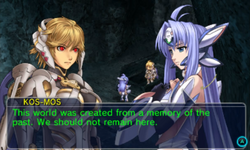
The logo of Xenosaga.

KOS-MOS is a blue-haired android who could be seen as the mascot of the Xenosaga series.
Xenosaga is primarily a series of futuristic science-fiction RPG video games developed by Monolith Soft and published by Namco / Bandai Namco.
The first episode released in February 2002 in Japan, while it was released in February 2003 in North America. The final third episode was released in 2006. The main story of Xenosaga is in the form of a trilogy of PlayStation 2 video games. Several side stories and spin-offs were also developed, as well an anime adaptation. Xenosaga characters have since been included in other video games, such as KOS-MOS' inclusion in crossover games like Project x Zone.
Xenosaga was originally intended to be about 6 episodes long, but due to budget, time constraints, and other factors, 3 episodes were released.
Xenosaga is an epic-sized space opera that opens in the outer reaches of the galaxy thousands of years in the future sometime in the year 6000-7277. Humanity has colonized over 500,000 planets in outerspace, and hasn't lived on Earth in over 4000 years. A new threat emerges in a mysterious race of hostile aliens known as Gnosis. The story follows several space-dwelling citizens as they aim to unlock the secrets of the universe.
Story[]
Plot summary[]
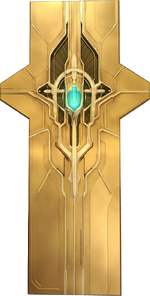
The Zohar: a central artifact in the Xenosaga series.
In Lake Turkana, Kenya, during an archaeological excavation, T. Masuda discovers the Zohar, a yellow artifact with mystical properties, in 20xx CE.
In the year T.C. 4767, which is 6767-7277 A.D, mankind exists on distant planets and artificial colonies. Humanity has abandoned Earth thousands of years ago, now referring to it as "Lost Jerusalem". The capital of all known space is Fifth Jerusalem, where the Galaxy Federation keeps watch over mankind and colonized 500,000 planets in the galaxy.
For the past fourteen years, mysterious alien enemies known as the Gnosis have terrorized colonies. Largely believed to have been brought into the universe by a scientist named Joachim Mizrahi during the Miltian Conflict of T.C. 4753, the Gnosis present a threat to humanity, but what they truly are, as well as what actually happened that day, remain undiscovered.

U-DO in Episode II.
The Zohar has become a topic of wider interest since its disappearance, along with all of Old Militia, during the Miltian Conflict. Several factions — chiefly the underground Ormus cult and the Galaxy Federation — wish to harness its power. Both groups believe that the Zohar's significance is threefold: as an unlimited source of power, the cause of the Gnosis crisis, and the virtual prison of U-DO, a formidable wave existence.
Before its disappearance, tests on the Zohar's powers have been conducted by Joachim Mizrahi, the Galaxy Federation, and a mysterious scientist known as Sellers, whose affiliation is with Ormus and the Hyams Group. The results of these tests were the development of several Zohar Emulators, or copies of the original Zohar. However, the original Zohar's power still eclipses the energy output of any known Emulator, despite the fact that one of the Emulators caused the disappearance of the planet Ariadne.
As a result of these discoveries and experiments, the Ormus society and the Galaxy Federation have grown obsessed with reclaiming the original Zohar. However, the key to unlocking Miltia and the Original Zohar is contained within the Y-Data, which is in the hands of a Realian called MOMO Mizrahi. In order to retrieve the Y-Data, Ormus must hatch a plot against the Galaxy Federation and its allies by using a series of dummy organizations and insiders, including the U-TIC Organization and an enigmatic figure known as Albedo Piazzolla.

Beginning of a Saga
Vector Industries develops the KOS-MOS Project.
Meanwhile, Vector Industries, the largest corporation in existence and the primary arms manufacturer for the Galaxy Federation, is currently researching new ways to use nanotechnology to build an unstoppable battle android, code-named KOS-MOS. This is quite controversial, since androids have been replaced for many years by artificial life-forms known as Realians, which have proven far more effective in combat. However, Vector Industries and their head of R&D, Shion Uzuki, have other ideas.
Shion, a simple researcher traveling on the starship Woglinde, becomes involved in a conspiracy not only to control the mysterious Gnosis and Original Zohar, but to reshape the destiny of all mankind.
Main characters[]
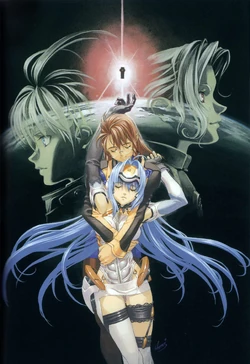
Shion's love for KOS-MOS is a core theme of Xenosaga.
Xenosaga features a cast that is slowly introduced as the series develops. The following is a brief description of the main characters featured in the series.
- Shion Uzuki — The main protagonist of the series. She is the chief engineer of Vector Industries' First R&D Division. Shion is a young woman who is the lead designer in the KOS-MOS project. She also specializes in Realian technology. However, as the plot develops and corruption is revealed, Shion distances herself from Vector.
- KOS-MOS — KOS-MOS is a female battle android developed by Vector Industries (primarily Shion and Kevin Winnicot). Although her development was delayed by an incident two years prior to Episode I, she becomes fully functional during the Woglinde disaster. KOS-MOS has a strong loyalty to Shion that is only overruled by unknown commands from Vector Industries.
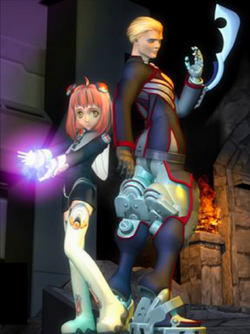
MOMO and Ziggy in Episode I.
- Ziggy — A combat cyborg who wishes to have the traumatic experiences of his prior life erased and to forget his humanity. Ziggurat 8 ("Ziggy") befriends MOMO while rescuing her from the U-TIC asteroid Pleroma during Episode I. Ziggy's past rises again in several instances, primarily in Episode II and Pied Piper.
- MOMO Mizrahi — A female 100-Series Observational Realian developed by Joachim Mizrahi and modeled after his daughter Sakura Mizrahi, MOMO is captured by the U-TIC Organization because she carries valuable information: the Y-Data. MOMO soon befriends Ziggurat 8 when he rescues her from Pleroma. As the story continues, MOMO also develops close relationships with Jr. and Ziggy, who work together to protect her.
- chaos — An enigmatic figure who appears to be a white-haired teenager. A member of the Elsa crew, chaos' origins are unknown. However, he does possess the power to destroy Gnosis with the touch of his hand.
- Jr. — The commander of the Durandal and co-director of the Kukai Foundation, which he runs with his co-director and fellow U.R.T.V., Gaignun Kukai. Jr. and Gaignun were both present during the Miltian Conflict, and their childhood experiences shaped their commitment to helping others exploited by the Life Recycling Act. Throughout Episode I and Episode II, Jr. develops a mentor-mentee relationship with MOMO.
- Jin Uzuki — Shion Uzuki's older brother, Jin Uzuki runs a bookstore on Second Miltia. However, he was once a sword-wielding Federation commander who attempted to unlock the truth behind the Miltian Conflict. In Episode II, he joins the quest to confirm what he learned about the Conflict.
- Allen Ridgeley — Shion's assistant and friend, Allen is the second in command of the KOS-MOS project. Although two years older than Shion, he is relatively new to Vector Industries and is her junior in the organization. Allen often acts shy around Shion because he is in love with her, although she is rather oblivious to this fact.
Themes[]
On the surface, Xenosaga is known for its story character drama elements, giant robot mech battles, spaceships, and technobabble.
However, on a deeper level, Xenosaga contains an alchemical mix of deep religious, spiritual, and philosophical overtones, delving into issues such as salvation, free will, morality, mental illness, trans-humanism, prejudice, science, and technology, among numerous others.
Intertwined with the symbolism of the series are themes of Friedrich Nietzsche, which all three episodes of the main Xenosaga trilogy are named after, as well as Jungian psychology, and elements from the Bible in general. Many key plot elements in the plot named after concepts from Gnosticism.
Like Xenogears, Xenosaga also contains religious and historical allusions that involve names and terms. For example, "KOS-MOS" is derived from the Greek 'kosmos', originally meaning "ornament or decoration", eventually coming to mean "universe, order, and harmony". Another example is chaos, who is also identified as "Yeshua". Furthermore, "Abel" and "Abel's Ark" are references to a biblical figure of the same name.
Buried beneath the mythological and psychological references are the questions the series asks, which often deal with the meaning of life and the truth behind figures and artifacts.
Primary PlayStation 2 trilogy[]
Xenosaga Episode I: Der Wille zur Macht[]
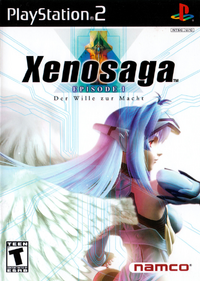
Episode I.
- Main article: Xenosaga Episode I: Der Wille zur Macht
Xenosaga Episode I: Der Wille zur Macht is the first title in the series. Der Wille zur Macht, can be translated as "The Will To Power", but "The Will to Make" is a better translation and is a reference to Nietzsche's thus named concept of an assumed rudimentary a-teleological force that elicits all activity stinted to existence itself.
Episode I serves as an exposition to the storyline; it introduces or mentions most of the main protagonists and antagonists, establishes a plot involving the Gnosis and the recovery of the Zohar Emulators, and provides foreshadowing to important past or future events. Several plot points such as the significance of the Miltian Conflict, the manipulators behind the U-TIC Organization, and the backstories and motivations of many characters are left unanswered for the player to question prior to playing Episode II.
Episode I generally received high marks, although critics were mixed about a variety of issues (see section).
The game's battle system introduces new concepts not common among popular RPG titles, and the majority of the soundtrack is performed by the London Philharmonic Orchestra.
Xenosaga Episode II: Jenseits von Gut und Böse[]
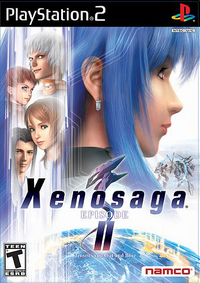
Episode II.
- Main article: Xenosaga Episode II: Jenseits von Gut und Böse
Xenosaga Episode II: Jenseits von Gut und Böse is the second installment in the series. Jenseits von Gut und Böse can be loosely translated as "Beyond Good and Evil", but it literally means "The other side of Good and Evil" and is taken from a philosophical book by Friedrich Nietzsche of the same name.
Episode II continues the storyline started in Episode I. The backstories and significance of Albedo Piazzolla, Nigredo/Gaignun, and Jr. are developed. Multiple secret organizations are uncovered, including Ormus and Hyams. The Gnosis take a back seat for Episode II; instead, the main plot focuses the search for the Zohar, which culminates in a crisis at the location of Old Miltia. The cast from Episode I plays an important role in the events that transpire on Old Miltia. Although there are several loose ends and characters unaccounted for in Episode II, it concludes without a sudden cliffhanger. This is underscored by the fact that Episode III will take place a full year later.
Episode II changes some elements compared to Episode I, including different graphics, a modified battle system, new music composers, and shorter cutscenes. These changes led to mixed results (see section). After the release of Episode II, several Monolith Soft employees were removed from the project.
Xenosaga Episode III: Also sprach Zarathustra[]
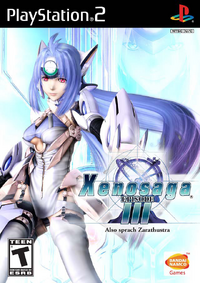
Episode III.
- Main article: Xenosaga Episode III: Also sprach Zarathustra
Xenosaga Episode III: Also sprach Zarathustra is the third and final game of the primary series. Also sprach Zarathustra, literally "Thus Spoke Zarathustra", is also the title to Nietzsche's most famous novel, which introduced the Übermensch and popularized the phrase "God is dead".
In September 2005, it was announced that Episode III would mark the premature end to the series, which was originally planned to span six titles. Episode III continues the storyline using the current cast of characters, with the addition of several new antagonists and playable characters (Allen, Miyuki, and Canaan). The release date for Episode III was July 7, 2006 for Japan, and August 29, 2006 for North America.
Side stories[]
Xenosaga: Pied Piper[]
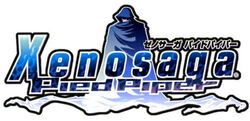
Xenosaga: Pied Piper logo.
- Main article: Xenosaga: Pied Piper
Released on phones in Japan, this Xenosaga side-story is set 100 years prior to the start of Episode I and explores the past of Ziggy during his former life as Jan Sauer, working for the Galaxy Federation's counter-terrorism task force. The purpose of Pied Piper is to develop the backstories of some of the most important presences in the Xenosaga universe, including Ziggy, chaos, Wilhelm, Voyager and Dr. Dmitri Yuriev. The plot itself spans three chapters. It centers on Sauer and his team as they track a serial killer known only by the hacker alias "Voyager", who murders his victims using the U.M.N. The game was also Soraya Saga's final contribution to the Xenosaga project.
Xenosaga I & II[]
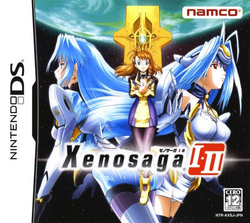
- Main article: Xenosaga I & II
Xenosaga I & II is a re-telling of the first two episodes of the game for the Nintendo DS handheld system. It is not an exact exact retelling of the previous two games; some minor changes were made. The Episode II portion of the game, originally told through Jr.'s perspective, focuses more on on Shion. The Episode II portion of the game is expanded and enhanced with new content (some of which was cut from the Episode II) from Xenosaga creator Tetsuya Takahashi.
The game plays out on the DS' top screen from the 3/4s perspective while the bottom touch screen is used to issue commands and navigate menus. The game's battle mechanics follow the style of Episode I as opposed to Episode II.
The game's script is by Yuichiro Takeda, who worked on Xenosaga: The Animation. Hiroshi Takeuchi, of Cowboy Bebop fame, is responsible for character art. Music for the game is composed by Kousuke Yamashita, who scored the soundtrack for Xenosaga: The Animation. Other previous work includes the Hana Yori Dango and Mahou Sentai Majirenjaa Tabidate live-action television series and Nobunaga's Ambition video game series. Yamashita is the fourth composer to score a Xenosaga video game, following Yasunori Mitsuda, Yuki Kajiura and Shinji Hosoe.
Xenosaga I & II was released in Japan on March 30th, 2006.
Other projects[]
Xenosaga: The Animation[]
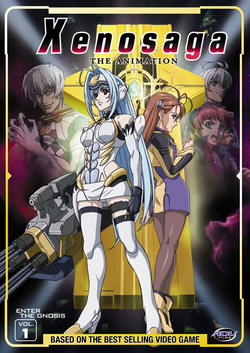
Vol 1. cover.
- Main article: Xenosaga: The Animation
A 12-episode anime based on Xenosaga Episode I, titled Xenosaga: The Animation, premiered in Japan on January 5, 2005.
The anime itself follows the story of Xenosaga closely, albeit removing several scenes and adding others. Some scenes were entirely re-written for the show's purposes. The pacing has the viewer running through the first ten to fifteen hours of gameplay of Episode I in the first five episodes. Given the nature of the anime, it works best as a supplement to Episode I; some points that the game explained poorly or didn't explain at all are brought to light in the anime.
Xenosaga: The Manga[]
- Main article: Xenosaga The Manga
In 2004, an official Japanese manga adaptation for Episode I was written by Atsushi Baba and published by Zero Sum Comics.
Xenogears connections[]
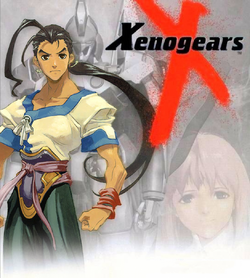
Xenogears.
The Xenosaga series serves as a spiritual successor to the game Xenogears, which was released in 1998 for the PlayStation by Squaresoft (now Square Enix). The creator of both Xenogears and Xenosaga is Tetsuya Takahashi, who left Squaresoft in 1999 along with Hirohide Sugiura. Using funds from Namco, they restarted Monolith Soft and the Xenosaga project.
Outside of allusions and homages, there is no direct relationship between the two storylines. Soraya Saga, who was the scenario writer for both Xenogears and Xenosaga, said this of the connection, "I think all Xeno works are, so to speak, like rivers and lakes that once sprung from our mind, eventually became independent. They sure are kin, but not lineal."[1]
Cameos and references in other games[]
- Xenosaga has been referenced in a number of Namco-Bandai properties, such as the Tales of Series, namely in item descriptions.
- KOS-MOS, in her version IV form, along with T-elos also appears in the role-playing game called Super Robot Taisen OG Saga: Endless Frontier.
Mugen no Frontier EXCEED KOS-MOS's All Attacks
KOS-MOS in Super Robot Taisen OG Saga: Endless Frontier Exceed.
- KOS-MOS appears as a character in Project X Zone, also by Monolith Soft, fighting alongside T-elos as a single unit. Again, this game is in continuity with Namco x Capcom and the Endless Frontier series.
- KOS-MOS appears again in the sequel Project X Zone 2, this time joined by Fiora from Xenoblade Chronicles.
- KOS-MOS appears as a character in Xenoblade Chronicles 2. She is a Rare Blade that can be randomly acquired by the protagonists. Her design is based on her Version 1 design, and is armed with twin Zohar-shaped Ether Cannons.
- Tales of the Rays: Recollection has a limited-time event featuring KOS-MOS, along with chaos', T-elos', and MOMO's outfits being made available as alternate limited-time costumes for the three Tales of characters being added in.
External links[]
- English translation of Xenosaga: Pied Piper
- English translation of A Missing Year
- Xeno Underground
- Xenoten's Translations of ODM translated
- XenoTen' s Translations of Perfect Guide


